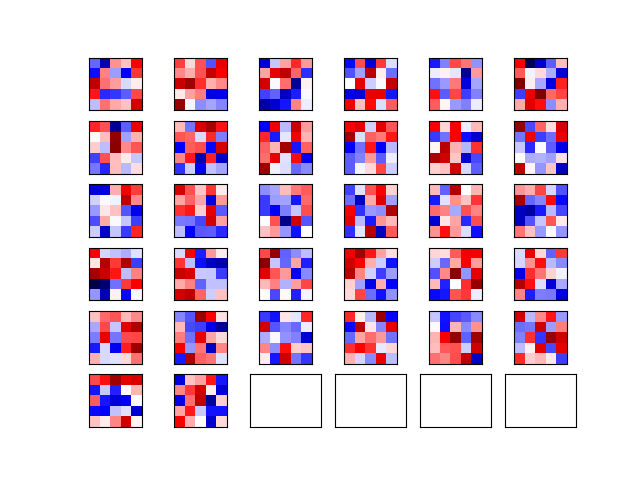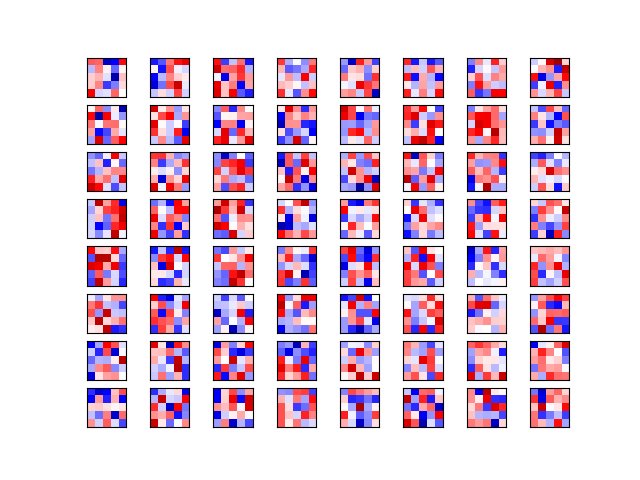一、TensorFlow介绍
1、什么是TensorFlow
- 官网:https://www.tensorflow.org/
- TensorFlow是Google开发的一款神经网络的Python外部的结构包, 也是一个采用数据流图来进行数值计算的开源软件库.
- 先绘制计算结构图, 也可以称是一系列可人机交互的计算操作, 然后把编辑好的Python文件 转换成 更高效的C++, 并在后端进行计算.
2、TensorFlow强大之处
- 擅长的任务就是训练深度神经网络
- 快速的入门神经网络,大大降低了深度学习(也就是深度神经网络)的开发成本和开发难度
- TensorFlow 的开源性, 让所有人都能使用并且维护
3、安装TensorFlow
- 暂不支持Windows下安装TensorFlow,可以在虚拟机里使用或者安装Docker安装
- 这里在CentOS6.5下进行安装
安装Python2.7,默认CentOS中安装的是Python2.6
先安装zlib的依赖,下面安装easy_install时会用到
12yum install zlibyum install zlib-devel在安装openssl的依赖,下面安装pip时会用到
12yum install opensslyum install openssl-devel下载安装包,我传到
github上的安装包,https协议后面加上--no-check-certificate,:1wget https://raw.githubusercontent.com/lawlite19/LinuxSoftware/master/python/Python-2.7.12.tgz --no-check-certificate解压缩:
tar -zxvf xxx- 进入,配置:
./configure --prefix=/usr/local/python2.7 - 编译并安装:
make && make install - 创建链接来使系统默认python变为python2.7,
ln -fs /usr/local/python2.7/bin/python2.7 /usr/bin/python - 修改一下yum,因为yum的执行文件还是需要原来的python2.6,
vim /usr/bin/yum1#!/usr/bin/python
修改为系统原有的python版本地址
1#!/usr/bin/python2.6
安装easy_install
- 下载:
wget https://raw.githubusercontent.com/lawlite19/LinuxSoftware/blob/master/python/setuptools-26.1.1.tar.gz --no-check-certificate - 解压缩:
tar -zxvf xxx python setup.py build#注意这里python是新的python2.7python setup.py install- 到
/usr/local/python2.7/bin目录下查看就会看到easy_install了 - 创建一个软连接:
ln -s /usr/local/python2.7/bin/easy_install /usr/local/bin/easy_install - 就可以使用
easy_install 包名进行安装
- 下载:
安装pip
- 下载:
- 解压缩:
tar -zxvf xxx - 安装:
python setup.py install - 到
/usr/local/python2.7/bin目录下查看就会看到pip了 - 同样创建软连接:
ln -s /usr/local/python2.7/bin/pip /usr/local/bin/pip - 就可以使用
pip install 包名进行安装包了
安装wingIDE
- 默认安装到
/usr/local/lib下,进入,执行./wing命令即可执行 - 创建软连接:
ln -s /usr/local/lib/wingide5.1/wing /usr/local/bin/wing - 破解:
- 默认安装到
[另]安装VMwareTools,可以在windows和Linux之间复制粘贴
- 启动CentOS
- 选择VMware中的虚拟机–>安装VMware Tools
- 会自动弹出VMware Tools的文件夹
- 拷贝一份到root目录下
cp VMwareTools-9.9.3-2759765.tar.gz /root - 解压缩
tar -zxvf VMwareTools-9.9.3-2759765.tar.gz - 进入目录执行,
vmware-install.pl,一路回车下去即可 - 重启CentOS即可
安装numpy
- 直接安装没有出错
安装scipy
- 安装依赖:
yum install bzip2-devel pcre-devel ncurses-devel readline-devel tk-devel gcc-c++ lapack-devel - 安装即可:
pip install scipy
- 安装依赖:
安装matplotlib
- 安装依赖:
yum install libpng-devel - 安装即可:
pip install matplotlib - 运行可能有以下的错误:1ImportError: No module named _tkinter
安装:
tcl8.5.9-src.tar.gz- 进入安装即可,
./confgiure make make install
安装:tk8.5.9-src.tar.gz - 进入安装即可。
- [注意]要重新安装一下Pyhton2.7才能链接到
tkinter
- 安装依赖:
安装scikit-learn
- 直接安装没有出错,但是缺少包
bz2 - 将系统中
python2.6的bz2复制到python2.7对应文件夹下1cp /usr/lib/python2.6/lib-dynload/bz2.so /usr/local/python2.7/lib/python2.7/lib-dynload
- 直接安装没有出错,但是缺少包
安装TensorFlow
- 官网点击
选择对应的版本
1234567891011121314151617181920212223242526272829303132# Ubuntu/Linux 64-bit, CPU only, Python 2.7$ export TF_BINARY_URL=https://storage.googleapis.com/tensorflow/linux/cpu/tensorflow-0.12.0rc0-cp27-none-linux_x86_64.whl# Ubuntu/Linux 64-bit, GPU enabled, Python 2.7# Requires CUDA toolkit 8.0 and CuDNN v5. For other versions, see "Installing from sources" below.$ export TF_BINARY_URL=https://storage.googleapis.com/tensorflow/linux/gpu/tensorflow_gpu-0.12.0rc0-cp27-none-linux_x86_64.whl# Mac OS X, CPU only, Python 2.7:$ export TF_BINARY_URL=https://storage.googleapis.com/tensorflow/mac/cpu/tensorflow-0.12.0rc0-py2-none-any.whl# Mac OS X, GPU enabled, Python 2.7:$ export TF_BINARY_URL=https://storage.googleapis.com/tensorflow/mac/gpu/tensorflow_gpu-0.12.0rc0-py2-none-any.whl# Ubuntu/Linux 64-bit, CPU only, Python 3.4$ export TF_BINARY_URL=https://storage.googleapis.com/tensorflow/linux/cpu/tensorflow-0.12.0rc0-cp34-cp34m-linux_x86_64.whl# Ubuntu/Linux 64-bit, GPU enabled, Python 3.4# Requires CUDA toolkit 8.0 and CuDNN v5. For other versions, see "Installing from sources" below.$ export TF_BINARY_URL=https://storage.googleapis.com/tensorflow/linux/gpu/tensorflow_gpu-0.12.0rc0-cp34-cp34m-linux_x86_64.whl# Ubuntu/Linux 64-bit, CPU only, Python 3.5$ export TF_BINARY_URL=https://storage.googleapis.com/tensorflow/linux/cpu/tensorflow-0.12.0rc0-cp35-cp35m-linux_x86_64.whl# Ubuntu/Linux 64-bit, GPU enabled, Python 3.5# Requires CUDA toolkit 8.0 and CuDNN v5. For other versions, see "Installing from sources" below.$ export TF_BINARY_URL=https://storage.googleapis.com/tensorflow/linux/gpu/tensorflow_gpu-0.12.0rc0-cp35-cp35m-linux_x86_64.whl# Mac OS X, CPU only, Python 3.4 or 3.5:$ export TF_BINARY_URL=https://storage.googleapis.com/tensorflow/mac/cpu/tensorflow-0.12.0rc0-py3-none-any.whl# Mac OS X, GPU enabled, Python 3.4 or 3.5:$ export TF_BINARY_URL=https://storage.googleapis.com/tensorflow/mac/gpu/tensorflow_gpu-0.12.0rc0-py3-none-any.whl对应
python版本12345# Python 2$ sudo pip install --upgrade $TF_BINARY_URL# Python 3$ sudo pip3 install --upgrade $TF_BINARY_URL可能缺少依赖
glibc,看对应提示的版本,- 还有可能报错1ImportError: /usr/lib64/libstdc++.so.6: version `GLIBCXX_3.4.19' not found (required by /usr/local/python2.7/lib/python2.7/site-packages/tensorflow/python/_pywrap_tensorflow.so)
安装对应版本的glibc
- 查看现有版本的glibc,
strings /lib64/libc.so.6 |grep GLIBC - 下载对应版本:
wget http://ftp.gnu.org/gnu/glibc/glibc-2.17.tar.gz - 解压缩:
tar -zxvf glibc-2.17 - 进入文件夹创建
build文件夹cd glibc-2.17 && mkdir build 配置:
123456../configure \--prefix=/usr \--disable-profile \--enable-add-ons \--enable-kernel=2.6.25 \--libexecdir=/usr/lib/glibc编译安装:
make && make install- 可以再用命令:
strings /lib64/libc.so.6 |grep GLIBC查看
- 查看现有版本的glibc,
添加GLIBCXX_3.4.19的支持
- 下载:
wget https://raw.githubusercontent.com/lawlite19/LinuxSoftware/master/python2.7_tensorflow/libstdc++.so.6.0.20 - 复制到
/usr/lib64文件夹下:cp libstdc++.so.6.0.20 /usr/lib64/ - 添加执行权限:
chmod +x /usr/lib64/libstdc++.so.6.0.20 - 删除原来的:
rm -rf /usr/lib64/libstdc++.so.6 - 创建软连接:
ln -s /usr/lib64/libstdc++.so.6.0.20 /usr/lib64/libstdc++.so.6 - 可以查看是否有个版本:
strings /usr/lib64/libstdc++.so.6 | grep GLIBCXX
- 下载:
运行还可能报错编码的问题,这里安装
0.10.0版本:pip install --upgrade https://storage.googleapis.com/tensorflow/linux/cpu/tensorflow-0.10.0rc0-cp27-none-linux_x86_64.whl安装
pandaspip install pandas没有问题
二、TensorFlow基础架构
1、处理结构
- Tensorflow 首先要定义神经网络的结构,然后再把数据放入结构当中去运算和 training

- TensorFlow是采用数据流图(data flow graphs)来计算
- 首先我们得创建一个数据流流图
- 然后再将我们的数据(数据以张量(tensor)的形式存在)放在数据流图中计算
- 张量(tensor):
- 张量有多种. 零阶张量为 纯量或标量 (scalar) 也就是一个数值. 比如 1
- 一阶张量为 向量 (vector), 比如 一维的 [1, 2, 3]
- 二阶张量为 矩阵 (matrix), 比如 二维的 [[1, 2, 3],[4, 5, 6],[7, 8, 9]]
- 以此类推, 还有 三阶 三维的 …
2、一个例子
求
y=1*x+3中的权重1和偏置3定义这个函数
12x_data = np.random.rand(100).astype(np.float32)y_data = x_data*1.0+3.0创建TensorFlow结构
1234567Weights = tf.Variable(tf.random_uniform([1], -1.0, 1.0)) # 创建变量Weight是,范围是 -1.0~1.0biases = tf.Variable(tf.zeros([1])) # 创建偏置,初始值为0y = Weights*x_data+biases # 定义方程loss = tf.reduce_mean(tf.square(y-y_data)) # 定义损失,为真实值减去我们每一步计算的值optimizer = tf.train.GradientDescentOptimizer(0.5) # 0.5 是学习率train = optimizer.minimize(loss) # 使用梯度下降优化init = tf.initialize_all_variables() # 初始化所有变量定义
Session12sess = tf.Session()sess.run(init)输出结果
1234for i in range(201):sess.run(train)if i%20 == 0:print i,sess.run(Weights),sess.run(biases)
结果为:
12345678910110 [ 1.60895896] [ 3.67376709]20 [ 1.04673827] [ 2.97489643]40 [ 1.011392] [ 2.99388123]60 [ 1.00277638] [ 2.99850869]80 [ 1.00067675] [ 2.99963641]100 [ 1.00016499] [ 2.99991131]120 [ 1.00004005] [ 2.99997854]140 [ 1.00000978] [ 2.99999475]160 [ 1.0000025] [ 2.99999857]180 [ 1.00000119] [ 2.99999928]200 [ 1.00000119] [ 2.99999928]
3、Session会话控制
- 运行
session.run()可以获得你要得知的运算结果, 或者是你所要运算的部分 - 定义常量矩阵:
tf.constant([[3,3]]) - 矩阵乘法 :
tf.matmul(matrix1,matrix2) 运行Session的两种方法:
手动关闭
123sess = tf.Session()print sess.run(product)sess.close()使用
with,执行完会自动关闭12with tf.Session() as sess:print sess.run(product)
4、Variable变量
- 定义变量:
tf.Variable() - 初始化所有变量:
init = tf.initialize_all_variables() - 需要再在 sess 里,
sess.run(init), 激活变量 - 输出时,一定要把 sess 的指针指向变量再进行
print才能得到想要的结果
5、Placeholder传入值
- 首先定义
Placeholder,然后在Session.run()的时候输入值 placeholder与feed_dict={}是绑定在一起出现的1234567input1 = tf.placeholder(tf.float32) #在 Tensorflow 中需要定义 placeholder 的 type ,一般为 float32 形式input2 = tf.placeholder(tf.float32)output = tf.mul(input1,input2) # 乘法运算with tf.Session() as sess:print sess.run(output,feed_dict={input1:7.,input2:2.}) # placeholder 与 feed_dict={} 是绑定在一起出现的
三、定义一个神经网络
1、添加层函数add_layer()
|
|
2、构建神经网络
定义二次函数
123x_data = np.linspace(-1,1,300,dtype=np.float32)[:,np.newaxis]noise = np.random.normal(0,0.05,x_data.shape).astype(np.float32)y_data = np.square(x_data)-0.5+noise定义
Placeholder,用于后期输入数据12xs = tf.placeholder(tf.float32,[None,1]) # None代表无论输入有多少都可以,只有一个特征,所以这里是1ys = tf.placeholder(tf.float32,[None,1])定义神经层
layer1layer1 = add_layer(xs, 1, 10, activation_function=tf.nn.relu) # 第一层,输入层为1,隐含层为10个神经元,Tensorflow 自带的激励函数tf.nn.relu定义输出层
1prediction = add_layer(layer1, 10, 1) # 利用上一层作为输入计算
loss损失1loss = tf.reduce_mean(tf.reduce_sum(tf.square(ys-prediction),reduction_indices=[1])) # 对二者差的平方求和再取平均梯度下降最小化损失
1train = tf.train.GradientDescentOptimizer(0.1).minimize(loss)初始化所有变量
1init = tf.initialize_all_variables()定义Session
12sess = tf.Session()sess.run(init)输出
1234for i in range(1000):sess.run(train,feed_dict={xs:x_data,ys:y_data})if i%50==0:print sess.run(loss,feed_dict={xs:x_data,ys:y_data})
结果:
3、可视化结果
- 显示数据12345fig = plt.figure()ax = fig.add_subplot(111)ax.scatter(x_data,y_data)plt.ion() # 绘画之后不暂停plt.show()
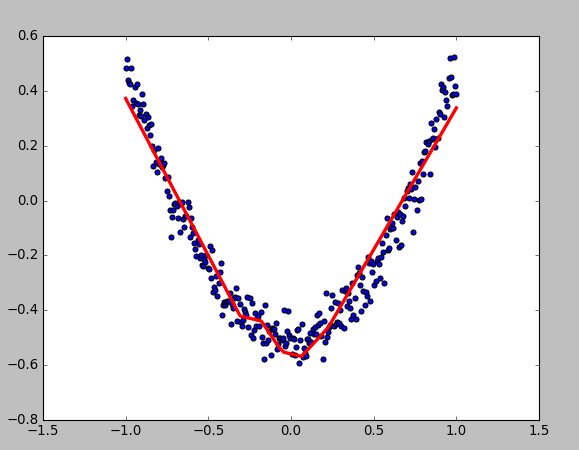
- 动态绘画123456789101112131415try:ax.lines.remove(lines[0]) # 每次绘画需要移除上次绘画的结果,放在try catch里因为第一次执行没有,所以直接passexcept Exception:passprediction_value = sess.run(prediction, feed_dict={xs: x_data})# plot the predictionlines = ax.plot(x_data, prediction_value, 'r-', lw=3) # 绘画plt.pause(0.1) # 停0.1s```![enter description here][3]## 四、TensorFlow可视化### 1、TensorFlow的可视化工具`tensorboard`,可视化神经网路额结构- 输入`input`
with tf.name_scope(‘input’):
xs = tf.placeholder(tf.float32,[None,1],name=’x_in’) #
ys = tf.placeholder(tf.float32,[None,1],name=’y_in’)
def add_layer(inputs,in_size,out_size,activation_function=None):
with tf.name_scope(‘layer’):
with tf.name_scope(‘Weights’):
Weights = tf.Variable(tf.random_normal([in_size,out_size]),name=’W’)
with tf.name_scope(‘biases’):
biases = tf.Variable(tf.zeros([1,out_size]) + 0.1,name=’b’)
with tf.name_scope(‘Ws_plus_b’):
Ws_plus_b = tf.matmul(inputs,Weights) + biases
if activation_function is None: outputs = Ws_plus_b
else:
outputs = activation_function(Ws_plus_b)
return outputs
with tf.name_scope(‘loss’):
loss = tf.reduce_mean(tf.reduce_sum(tf.square(ys-prediction),reduction_indices=1))
with tf.name_scope(‘train’):
train = tf.train.GradientDescentOptimizer(0.1).minimize(loss)
writer = tf.train.SummaryWriter(“logs/“, sess.graph)
layer_name = ‘layer%s’%n_layer
def add_layer(inputs,in_size,out_size,n_layer,activation_function=None):
layer_name = ‘layer%s’%n_layer
with tf.name_scope(layer_name):
with tf.name_scope(‘Weights’):
Weights = tf.Variable(tf.random_normal([in_size,out_size]),name=’W’)
tf.histogram_summary(layer_name+’/weights’, Weights)
with tf.name_scope(‘biases’):
biases = tf.Variable(tf.zeros([1,out_size]) + 0.1,name=’b’)
tf.histogram_summary(layer_name+’/biases’,biases)
with tf.name_scope(‘Ws_plus_b’):
Ws_plus_b = tf.matmul(inputs,Weights) + biases
if activation_function is None:
outputs = Ws_plus_b
else:
outputs = activation_function(Ws_plus_b)
tf.histogram_summary(layer_name+'/outputs',outputs)
return outputs
|
|
merged =tf.merge_all_summaries()
writer = tf.train.SummaryWriter(“logs/“, sess.graph)
for i in range(1000):
sess.run(train,feed_dict={xs:x_data,ys:y_data})
if i%50==0:
summary = sess.run(merged, feed_dict={xs: x_data, ys:y_data})
writer.add_summary(summary, i)
‘’’添加一层神经网络’’’
def add_layer(inputs,in_size,out_size,activation_function=None):
Weights = tf.Variable(tf.random_normal([in_size,out_size])) # 权重,in*out
biases = tf.Variable(tf.zeros([1,out_size]) + 0.1)
Ws_plus_b = tf.matmul(inputs,Weights) + biases # 计算权重和偏置之后的值
if activation_function is None:
outputs = Ws_plus_b
else:
outputs = activation_function(Ws_plus_b) # 调用激励函数运算
return outputs
‘’’运行函数’’’
def NeuralNetwork():
data_digits = spio.loadmat(‘data_digits.mat’)
X = data_digits[‘X’]
y = data_digits[‘y’]
m,n = X.shape
class_y = np.zeros((m,10)) # y是0,1,2,3…9,需要映射0/1形式
for i in range(10):
class_y[:,i] = np.float32(y==i).reshape(1,-1)
xs = tf.placeholder(tf.float32, shape=[None,400]) # 像素是20x20=400,所以有400个feature
ys = tf.placeholder(tf.float32, shape=[None,10]) # 输出有10个
prediction = add_layer(xs, 400, 10, activation_function=tf.nn.softmax) # 两层神经网络,400x10
#prediction = add_layer(layer1, 25, 10, activation_function=tf.nn.softmax)
#loss = tf.reduce_mean(tf.reduce_sum(tf.square(ys-prediction),reduction_indices=[1]))
loss = tf.reduce_mean(-tf.reduce_sum(ys*tf.log(prediction),reduction_indices=[1])) # 定义损失函数(代价函数),
train = tf.train.GradientDescentOptimizer(learning_rate=0.5).minimize(loss) # 使用梯度下降最小化损失
init = tf.initialize_all_variables() # 初始化所有变量
sess = tf.Session() # 创建Session
sess.run(init)
for i in range(4000): # 迭代训练4000次
sess.run(train, feed_dict={xs:X,ys:class_y}) # 训练train,填入数据
if i%50==0: # 每50次输出当前的准确度
print(compute_accuracy(xs,ys,X,class_y,sess,prediction))
|
|
‘’’计算预测准确度’’’
def compute_accuracy(xs,ys,X,y,sess,prediction):
y_pre = sess.run(prediction,feed_dict={xs:X})
correct_prediction = tf.equal(tf.argmax(y_pre,1),tf.argmax(y,1)) #tf.argmax 给出某个tensor对象在某一维上的其数据最大值所在的索引值,即为对应的数字,tf.equal 来检测我们的预测是否真实标签匹配
accuracy = tf.reduce_mean(tf.cast(correct_prediction,tf.float32)) # 平均值即为准确度
result = sess.run(accuracy,feed_dict={xs:X,ys:y})
return result
for i in range(2000):
batch_xs, batch_ys = minist.train.next_batch(100)
sess.run(train_step,feed_dict={xs:batch_xs,ys:batch_ys})
if i%50==0:
print(compute_accuracy(xs,ys,minist.test.images, minist.test.labels,sess,prediction))
|
|
‘’’权重初始化函数’’’
def weight_variable(shape):
inital = tf.truncated_normal(shape, stddev=0.1) # 使用truncated_normal进行初始化
return tf.Variable(inital)
‘’’偏置初始化函数’’’
def bias_variable(shape):
inital = tf.constant(0.1,shape=shape) # 偏置定义为常量
return tf.Variable(inital)
‘’’卷积函数’’’
def conv2d(x,W):#x是图片的所有参数,W是此卷积层的权重
return tf.nn.conv2d(x,W,strides=[1,1,1,1],padding=’SAME’)#strides[0]和strides3的两个1是默认值,中间两个1代表padding时在x方向运动1步,y方向运动1步
‘’’池化函数’’’
def max_pool_2x2(x):
return tf.nn.max_pool(x,ksize=[1,2,2,1],
strides=[1,2,2,1], padding=’SAME’)#池化的核函数大小为2x2,因此ksize=[1,2,2,1],步长为2,因此strides=[1,2,2,1]
mnist = input_data.read_data_sets('MNIST_data', one_hot=True) # 下载数据
xs = tf.placeholder(tf.float32,[None,784]) # 输入图片的大小,28x28=784
ys = tf.placeholder(tf.float32,[None,10]) # 输出0-9共10个数字
keep_prob = tf.placeholder(tf.float32) # 用于接收dropout操作的值,dropout为了防止过拟合
x_image = tf.reshape(xs,[-1,28,28,1]) #-1代表先不考虑输入的图片例子多少这个维度,后面的1是channel的数量,因为我们输入的图片是黑白的,因此channel是1,例如如果是RGB图像,那么channel就是3
|
|
'''第一层卷积,池化'''
W_conv1 = weight_variable([5,5,1,32]) # 卷积核定义为5x5,1是输入的通道数目,32是输出的通道数目
b_conv1 = bias_variable([32]) # 每个输出通道对应一个偏置
h_conv1 = tf.nn.relu(conv2d(x_image,W_conv1)+b_conv1) # 卷积运算,并使用ReLu激活函数激活
h_pool1 = max_pool_2x2(h_conv1) # pooling操作
|
|
'''第二层卷积,池化'''
W_conv2 = weight_variable([5,5,32,64]) # 卷积核还是5x5,32个输入通道,64个输出通道
b_conv2 = bias_variable([64]) # 与输出通道一致
h_conv2 = tf.nn.relu(conv2d(h_pool1, W_conv2)+b_conv2)
h_pool2 = max_pool_2x2(h_conv2)
|
|
'''全连接层'''
h_pool2_flat = tf.reshape(h_pool2, [-1,7*7*64]) # 将最后操作的数据展开
W_fc1 = weight_variable([7*7*64,1024]) # 下面就是定义一般神经网络的操作了,继续扩大为1024
b_fc1 = bias_variable([1024]) # 对应的偏置
h_fc1 = tf.nn.relu(tf.matmul(h_pool2_flat,W_fc1)+b_fc1) # 运算、激活(这里不是卷积运算了,就是对应相乘)
|
|
'''dropout'''
h_fc1_drop = tf.nn.dropout(h_fc1,keep_prob) # dropout操作
|
|
'''最后一层全连接'''
W_fc2 = weight_variable([1024,10]) # 最后一层权重初始化
b_fc2 = bias_variable([10]) # 对应偏置
prediction = tf.nn.softmax(tf.matmul(h_fc1_drop,W_fc2)+b_fc2) # 使用softmax分类器
cross_entropy = tf.reduce_mean(-tf.reduce_sum(ys*tf.log(prediction),reduction_indices=[1])) # 交叉熵损失函数来定义cost function
train_step = tf.train.AdamOptimizer(1e-3).minimize(cross_entropy) # 调用梯度下降
|
|
'''下面就是tf的一般操作,定义Session,初始化所有变量,placeholder传入值训练'''
sess = tf.Session()
sess.run(tf.initialize_all_variables())
for i in range(1000):
batch_xs, batch_ys = mnist.train.next_batch(100) # 使用SGD,每次选取100个数据训练
sess.run(train_step, feed_dict={xs: batch_xs, ys: batch_ys, keep_prob: 0.5}) # dropout值定义为0.5
if i % 50 == 0:
print compute_accuracy(xs,ys,mnist.test.images, mnist.test.labels,keep_prob,sess,prediction) # 每50次输出一下准确度
|
|
‘’’计算准确度函数’’’
def compute_accuracy(xs,ys,X,y,keep_prob,sess,prediction):
y_pre = sess.run(prediction,feed_dict={xs:X,keep_prob:1.0}) # 预测,这里的keep_prob是dropout时用的,防止过拟合
correct_prediction = tf.equal(tf.argmax(y_pre,1),tf.argmax(y,1)) #tf.argmax 给出某个tensor对象在某一维上的其数据最大值所在的索引值,即为对应的数字,tf.equal 来检测我们的预测是否真实标签匹配
accuracy = tf.reduce_mean(tf.cast(correct_prediction,tf.float32)) # 平均值即为准确度
result = sess.run(accuracy,feed_dict={xs:X,ys:y,keep_prob:1.0})
return result
W = tf.Variable(initial_value=[[1,2,3],[3,4,5]],
name=’weights’, dtype=tf.float32) # 注意需要指定name和dtype
b = tf.Variable(initial_value=[1,2,3],
name=’biases’, dtype=tf.float32)
init = tf.initialize_all_variables()
saver = tf.train.Saver()
with tf.Session() as sess:
sess.run(init)
save_path = saver.save(sess, ‘my_network/save_net.ckpt’) # 保存目录,注意要在当前项目下建立my_network的目录
print (‘保存到 :’,save_path)
W = tf.Variable(np.arange(6).reshape((2,3)),
name=’weights’, dtype=tf.float32) # 注意与之前保存的一致
b = tf.Variable(np.arange((3)),
name=’biases’, dtype=tf.float32)
saver = tf.train.Saver()
with tf.Session() as sess:
saver.restore(sess,’my_network/save_net.ckpt’)
print(‘weights:’,sess.run(W)) # 输出一下结果
print(‘biases:’,sess.run(b))
2、绘制9张图像
实现函数
1234567891011121314151617181920'''define a funciton to plot 9 images'''def plot_images(images, cls_true, cls_pred = None):'''@parameter images: the images info@parameter cls_true: the true value of image@parameter cls_pred: the prediction value, default is None'''assert len(images) == len(cls_true) == 9 # only show 9 imagesfig, axes = plt.subplots(nrows=3, ncols=3)for i, ax in enumerate(axes.flat):ax.imshow(images[i].reshape(img_shape), cmap="binary") # binary means black_white image# show the true and pred valuesif cls_pred is None:xlabel = "True: {0}".format(cls_true[i])else:xlabel = "True: {0},Pred: {1}".format(cls_true[i],cls_pred[i])ax.set_xlabel(xlabel)ax.set_xticks([]) # remove the ticksax.set_yticks([])plt.show()选择测试集中的9张图显示
|
|
- 定义
weights和biases
|
|
- 定义模型
|
|
- 定义求准确度
|
|
- 定义
session
|
|
4、定义函数optimize进行bgd训练
|
|
5、定义输出准确度的函数
代码
1234567feed_dict_test = {X: data.test.images,y_true: data.test.labels,y_true_cls: data.test.cls}'''define a function to print the accuracy'''def print_accuracy():acc = session.run(accuracy, feed_dict=feed_dict_test)print("Accuracy on test-set:{0:.1%}".format(acc))输出:
Accuracy on test-set:89.4%
6、定义绘制错误预测的图片函数
代码
12345678'''define a function to plot the error prediciton'''def plot_example_errors():correct, cls_pred = session.run([correct_prediction, y_pred_cls], feed_dict=feed_dict_test)incorrect = (correct == False)images = data.test.images[incorrect] # get the prediction error imagescls_pred = cls_pred[incorrect] # get prediction valuecls_true = data.test.cls[incorrect] # get true valueplot_images(images[0:9], cls_true[0:9], cls_pred[0:9])输出:
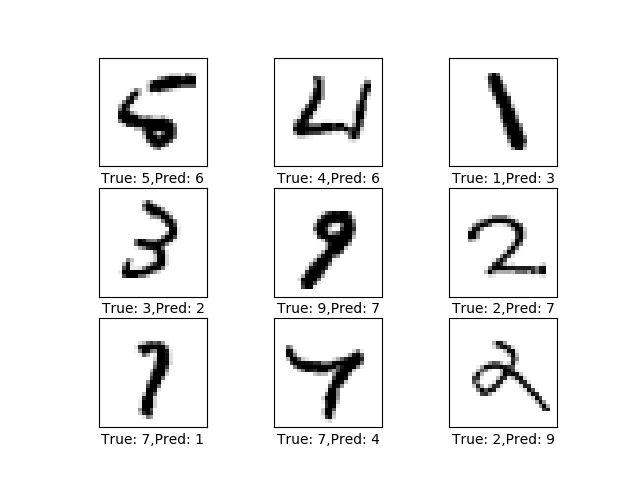
7、定义可视化权重的函数
代码
123456789101112131415'''define a fucntion to plot weights'''def plot_weights():w = session.run(weights)w_min = np.min(w)w_max = np.max(w)fig, axes = plt.subplots(3, 4)fig.subplots_adjust(0.3, 0.3)for i, ax in enumerate(axes.flat):if i<10:image = w[:,i].reshape(img_shape)ax.set_xlabel("Weights: {0}".format(i))ax.imshow(image, vmin=w_min,vmax=w_max,cmap="seismic")ax.set_xticks([])ax.set_yticks([])plt.show()输出:
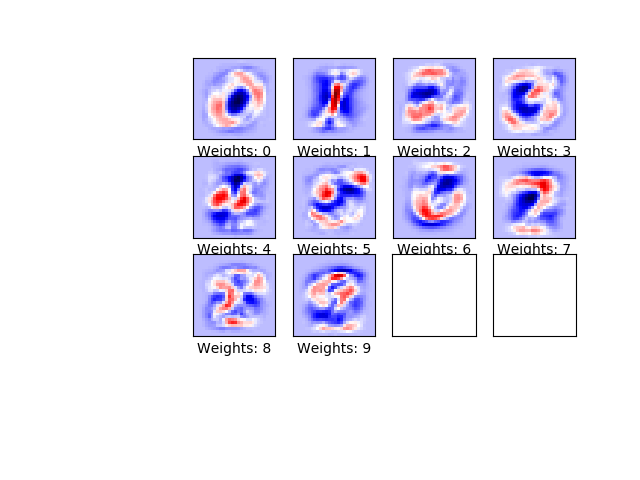
8、定义输出
confusion_matrix的函数代码:
12345678910111213141516'''define a function to printand plot the confusion matrix using scikit-learn.'''def print_confusion_martix():cls_true = data.test.cls # test set actual valuecls_pred = session.run(y_pred_cls, feed_dict=feed_dict_test) # test set predict valuecm = confusion_matrix(y_true=cls_true,y_pred=cls_pred) # use sklearn confusion_matrixprint(cm)plt.imshow(cm, interpolation='nearest',cmap=plt.cm.Blues) # Plot the confusion matrix as an image.plt.tight_layout()plt.colorbar()tick_marks = np.arange(num_classes)tick_marks = np.arange(num_classes)plt.xticks(tick_marks, range(num_classes))plt.yticks(tick_marks, range(num_classes))plt.xlabel('Predicted')plt.ylabel('True')plt.show()输出:
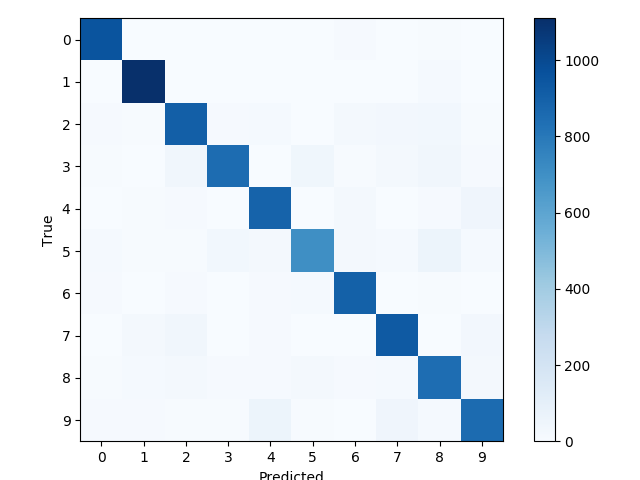
十:CNN
- 全部代码
- 使用
MNIST数据集 - 加载数据,绘制9张图等函数与上面一致,
readme中不再写出
1、定义CNN所需要的变量
|
|
2、初始化weights和biases的函数
|
|
3、定义卷积操作和池化(如果使用的话)的函数
|
|
4、定义将卷积层展开的函数
|
|
5、定义全连接层的函数
|
|
6、定义模型
- 定义
placeholder
|
|
- 定义卷积、dropout、和全连接
|
|
- 定义求准确度
|
|
7、定义训练的函数optimize,使用bgd
代码:
1234567891011121314151617181920'''define a function to run train the model with bgd'''total_iterations = 0 # record the total iterationsdef optimize(num_iterations):'''@param num_iterations: the total interations of train batch_size operation'''global total_iterationsstart_time = time.time()for i in range(total_iterations,total_iterations + num_iterations):x_batch, y_batch = data.train.next_batch(batch_size)feed_dict = {X: x_batch, y_true: y_batch, keep_prob: 0.5}session.run(optimizer, feed_dict=feed_dict)if i % 10 == 0:acc = session.run(accuracy, feed_dict=feed_dict)msg = "Optimization Iteration: {0:>6}, Training Accuracy: {1:>6.1%}" # {:>6}means the fixed width,{1:>6.1%}means the fixed width is 6 and keep 1 decimal placeprint(msg.format(i + 1, acc))total_iterations += num_iterationsend_time = time.time()time_dif = end_time-start_timeprint("time usage:"+str(timedelta(seconds=int(round(time_dif)))))输出:
|
|
8、定义批量预测的函数,方便输出训练错的图像
|
|
9、定义可视化卷积核权重的函数
代码:
12345678910111213141516171819'''define a function to plot conv weights'''def plot_conv_weights(weights,input_channel=0):'''@param weights: the conv filter weights, for example: the weights_conv1 and weights_conv2, which are 4 dimension [filter_size, filter_size, num_input_channels, num_output_filters]@param input_channel: the input_channels'''w = session.run(weights)w_min = np.min(w)w_max = np.max(w)num_filters = w.shape[3] # get the number of filtersnum_grids = math.ceil(math.sqrt(num_filters))fig, axes = plt.subplots(num_grids, num_grids)for i, ax in enumerate(axes.flat):if i < num_filters:img = w[:,:,input_channel,i] # the ith weightax.imshow(img,vmin=w_min,vmax=w_max,interpolation="nearest",cmap='seismic')ax.set_xticks([])ax.set_yticks([])plt.show()输出:
代码:
123456789101112131415161718'''define a function to plot conv output layer'''def plot_conv_layer(layer, image):'''@param layer: the conv layer, which is also a image after conv@param image: the image info'''feed_dict = {X:[image]}values = session.run(layer, feed_dict=feed_dict)num_filters = values.shape[3] # get the number of filtersnum_grids = math.ceil(math.sqrt(num_filters))fig, axes = plt.subplots(num_grids,num_grids)for i, ax in enumerate(axes.flat):if i < num_filters:img = values[0,:,:,i]ax.imshow(img, interpolation="nearest",cmap="binary")ax.set_xticks([])ax.set_yticks([])plt.show()输出:
- 第一层:
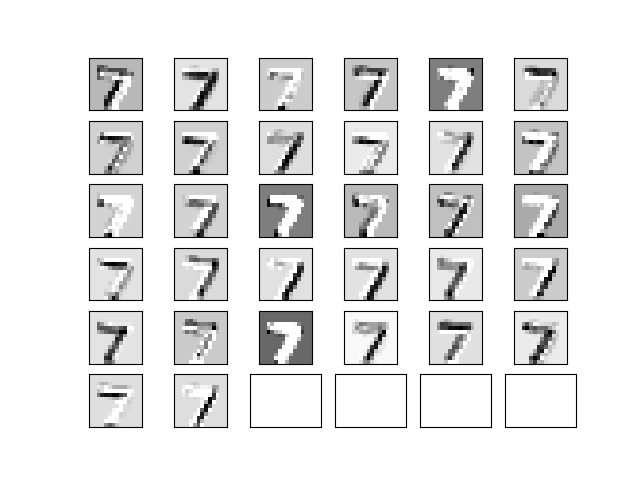
- 第二层:
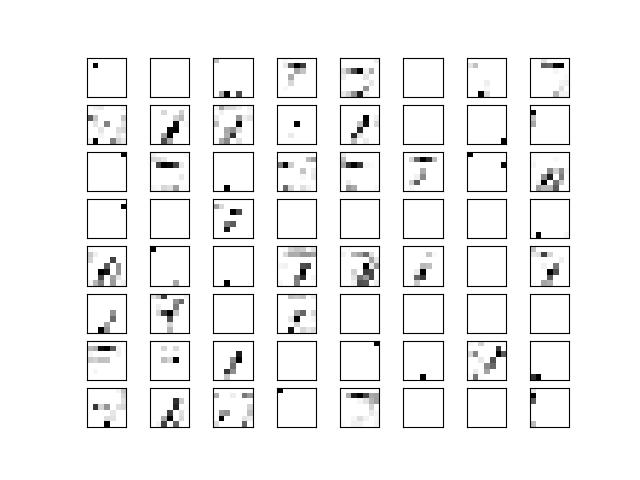
- 第一层:
十一:使用prettytensor实现CNNModel
- 全部代码
- 使用
MNIST数据集 - 加载数据,绘制9张图等函数与九一致,
readme中不再写出1、定义模型
- 定义
placeholder,与之前的一致
|
|
- 使用
prettytensor实现CNN模型
|
|
- 获取卷积核的权重(后续可视化)
|
|
- 定义
optimizer训练,和之前的一样了
|
|
十二:CNN,保存和加载模型,使用Early Stopping
- 全部代码
- 使用
MNIST数据集 - 加载数据,绘制9张图等函数与九一致,
readme中不再写出 - CNN模型的定义和十一中的一致,
readme中不再写出1、保存模型
- 创建saver,和保存的目录
|
|
- 保存session,对应到下面2中的Early Stopping,将最好的模型保存
|
|
2、Early Stopping
|
|
- 调用
optimize(10000)输出信息
|
|
可以看到最后10次输出(每100次输出一次)在验证集上准确度都没有提高,停止执行
3、 小批量预测并计算准确率
因为需要预测测试集和验证集,这里参数指定需要的images
1234567891011121314'''define a function to predict using batch'''batch_size_predict = 256def predict_cls(images, labels, cls_true):num_images = len(images)cls_pred = np.zeros(shape=num_images, dtype=np.int)i = 0while i < num_images:j = min(i+batch_size_predict, num_images)feed_dict = {X: images[i:j,:],y_true: labels[i:j,:]}cls_pred[i:j] = session.run(y_pred_cls, feed_dict=feed_dict)i = jcorrect = (cls_true==cls_pred)return correct, cls_pred测试集和验证集直接调用即可
|
|
- 计算验证集准确率(上面optimize函数中需要用到)
|
|
- 计算测试集准确率,并且输出错误的预测和confusion matrix
|
|
十二:模型融合
- 全部代码
- 使用
MNIST数据集 - 一些方法和之前的一致,不在给出
- 其中训练了多个CNN 模型,然后取预测的平均值作为最后的预测结果
1、将测试集和验证集合并后,并重新划分
- 主要是希望训练时数据集有些变换,否则都是一样的数据去训练了,最后再融合意义不大12345678910111213141516171819'''将training set和validation set合并,并重新划分'''combine_images = np.concatenate([data.train.images, data.validation.images], axis=0)combine_labels = np.concatenate([data.train.labels, data.validation.labels], axis=0)print("合并后图片:", combine_images.shape)print("合并后label:", combine_labels.shape)combined_size = combine_labels.shape[0]train_size = int(0.8*combined_size)validation_size = combined_size - train_size'''函数:将合并后的重新随机划分'''def random_training_set():idx = np.random.permutation(combined_size) # 将0-combined_size数字随机排列idx_train = idx[0:train_size]idx_validation = idx[train_size:]x_train = combine_images[idx_train, :]y_train = combine_labels[idx_train, :]x_validation = combine_images[idx_validation, :]y_validation = combine_images[idx_validation, :]return x_train, y_train, x_validation, y_validation
2、融合模型
加载训练好的模型,并输出每个模型在测试集的预测结果等
1234567891011121314151617def ensemble_predictions():pred_labels = []test_accuracies = []validation_accuracies = []for i in range(num_networks):saver.restore(sess=session, save_path=get_save_path(i))test_acc = test_accuracy()test_accuracies.append(test_acc)validation_acc = validation_accuracy()validation_accuracies.append(validation_acc)msg = "网络:{0},验证集:{1:.4f},测试集{2:.4f}"print(msg.format(i, validation_acc, test_acc))pred = predict_labels(data.test.images)pred_labels.append(pred)return np.array(pred_labels),\np.array(test_accuracies),\np.array(validation_accuracies)调用
pred_labels, test_accuracies, val_accuracies = ensemble_predictions()- 取均值:
ensemble_pred_labels = np.mean(pred_labels, axis=0) - 融合后的真实结果:
ensemble_cls_pred = np.argmax(ensemble_pred_labels, axis=1) - 其他一些信息:
|
|
十二:Cifar-10数据集,使用variable_scope重复使用变量
- 全部代码
- 使用
CIFAR-10数据集 - 创建了两个网络,一个用于训练,一个用于测试,测试使用的是训练好的权重参数,所以用到参数重用
- 网络结构

1、数据集
导入包:
- 这是别人实现好的下载和处理
cifar-10数据集的diamante12import cifar10from cifar10 import img_size, num_channels, num_classes
- 这是别人实现好的下载和处理
输出一些数据集信息
|
|
- 显示9张图片函数
- 相比之前的,加入了
smooth
- 相比之前的,加入了
|
|
2、定义placeholder
|
|
3、图片处理
单张图片处理
- 原图是
32*32像素的,裁剪成24*24像素的 - 如果是训练集进行一些裁剪,翻转,饱和度等处理
- 如果是测试集,只进行简单的裁剪处理
- 这也是为什么使用
variable_scope定义两个网络123456789101112131415'''单个图片预处理, 测试集只需要裁剪就行了'''def pre_process_image(image, training):if training:image = tf.random_crop(image, size=[img_size_cropped, img_size_cropped, num_channels]) # 裁剪image = tf.image.random_flip_left_right(image) # 左右翻转image = tf.image.random_hue(image, max_delta=0.05) # 色调调整image = tf.image.random_brightness(image, max_delta=0.2) # 曝光image = tf.image.random_saturation(image, lower=0.0, upper=2.0) # 饱和度'''上面的调整可能pixel值超过[0, 1], 所以约束一下'''image = tf.minimum(image, 1.0)image = tf.maximum(image, 0.0)else:image = tf.image.resize_image_with_crop_or_pad(image, target_height=img_size_cropped,target_width=img_size_cropped)return image
- 原图是
多张图片处理
- 因为训练和测试是都是使用
batch的方式 - 调用上面处理单张图片的函数
- tf.map_fn(fn, elems)函数,前面一般是
lambda函数,后面是所有的数据1234'''调用上面的函数,处理多个图片images'''def pre_process(images, training):images = tf.map_fn(lambda image: pre_process_image(image, training), images) # tf.map_fn()使用lambda函数return images
- 因为训练和测试是都是使用
4、定义tensorflow计算图
- 定义主网络图
- 使用
prettytensor - 分为
training和test两个阶段
- 使用
|
|
创建所有网络,包含预处理图片和主网络
- 需要使用variable_scope, 测试阶段需要
reuse训练阶段的参数12345678'''创建所有网络, 包含预处理和主网络,'''def create_network(training):# 使用variable_scope可以重复使用定义的变量,训练时创建新的,测试时重复使用with tf.variable_scope("network", reuse=not training):images = Ximages = pre_process(images=images, training=training)y_pred, loss = main_network(images=images, training=training)return y_pred, loss
- 需要使用variable_scope, 测试阶段需要
创建训练阶段网络
- 定义一个
global_step记录训练的次数,下面会将其保存到checkpoint,trainable为False就不会训练改变123456'''训练阶段网络创建'''global_step = tf.Variable(initial_value=0,name="global_step",trainable=False) # trainable 在训练阶段不会改变_, loss = create_network(training=True)optimizer = tf.train.AdamOptimizer(learning_rate=0.0001).minimize(loss, global_step)
- 定义一个
定义测试阶段网络
- 同时定义准确率
|
|
5、获取权重和每层的输出值信息
- 获取权重变量
|
|
- 获取每层的输出变量
|
|
6、保存和加载计算图参数
- 因为第一次不会加载,所以放到
try中判断
|
|
7、训练
- 获取
batch
|
|
- 训练网络
- 每1000次保存一下
checkpoint - 因为上面会
restored已经保存训练的网络,同时也保存了训练的次数,所以可以接着训练1234567891011121314151617def optimize(num_iterations):start_time = time.time()for i in range(num_iterations):x_batch, y_batch = random_batch()feed_dict_train = {X: x_batch, y_true: y_batch}i_global, _ = session.run([global_step, optimizer], feed_dict=feed_dict_train)if (i_global%100==0) or (i == num_iterations-1):batch_acc = session.run(accuracy, feed_dict=feed_dict_train)msg = "global step: {0:>6}, training batch accuracy: {1:>6.1%}"print(msg.format(i_global, batch_acc))if(i_global%1000==0) or (i==num_iterations-1):saver.save(session, save_path=save_path,global_step=global_step)print("保存checkpoint")end_time = time.time()time_diff = end_time-start_timeprint("耗时:", str(timedelta(seconds=int(round(time_diff)))))
- 每1000次保存一下
十三、Inception model (GoogleNet)
- 全部代码
- 使用训练好的
inception model,因为模型很复杂,一般的电脑运行不起来的。 - 网络结构
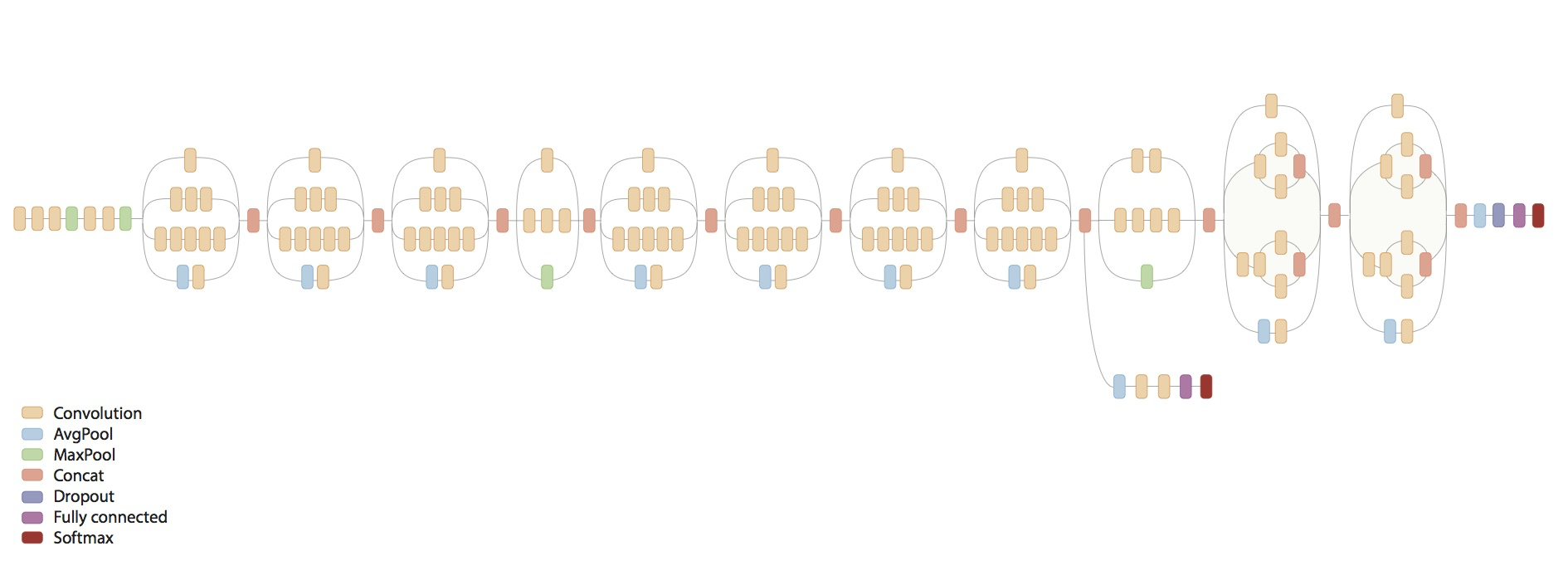
1、下载和加载inception model
- 因为是预训练好的模型,所以无需我们定义结构了
导入包
- 这里
inception是别人实现好的下载的代码12345import numpy as npimport tensorflow as tffrom matplotlib import pyplot as pltimport inception # 第三方类加载inception modelimport os
- 这里
下载和加载模型
123'''下载和加载inception model'''inception.maybe_download()model = inception.Inception()预测和显示图片函数
|
|
- 显示调整后的图片
- 因为
inception model要求输入图片为299*299像素的,所以它会resize成这个大小然后作为输入
- 因为
|
|
十四、迁移学习 Transfer Learning
- 全部代码
- 网络结构还是使用上一节的
inception model, 去掉最后的全连接层,然后重新构建全连接层进行训练- 因为
inception model是训练好的,前面的卷积层用于捕捉特征, 而后面的全连接层可用于分类,所以我们训练全连接层即可
- 因为
- 因为要计算每张图片的
transfer values,所以使用一个cache缓存transfer-values,第一次计算完成后,后面重新运行直接读取存储的结果,这样比较节省时间transfer values是inception model在Softmax层前一层的值cifar-10数据集, 我放在实验室电脑上运行了几个小时才得到transfer values,还是比较慢的
- 总之最后相当于训练下面的神经网络,对应的
transfer-values作为输入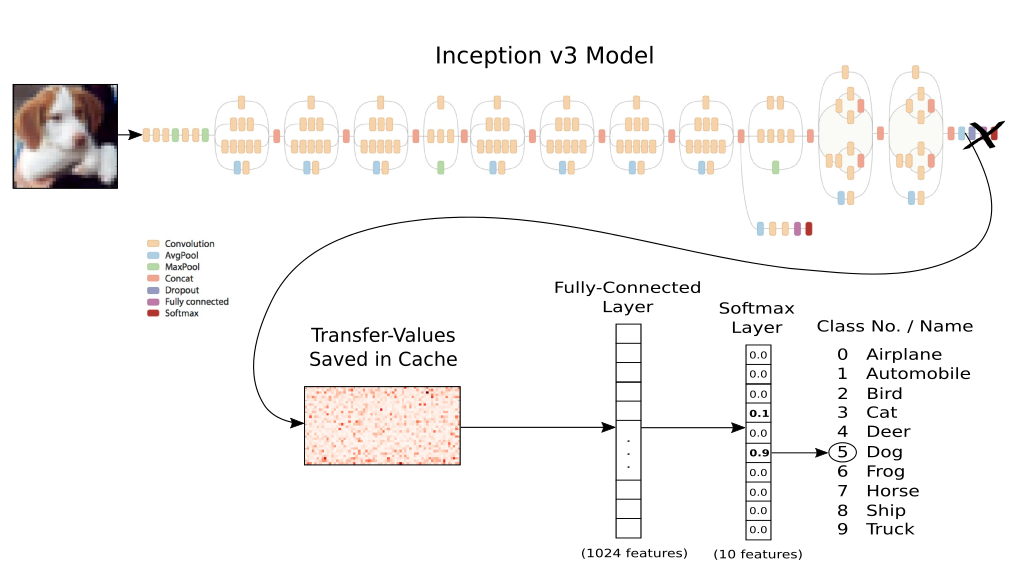
1、准备工作
导入包
1234567891011import numpy as npimport tensorflow as tfimport prettytensor as ptfrom matplotlib import pyplot as pltimport timefrom datetime import timedeltaimport osimport inception # 第三方下载inception model的代码from inception import transfer_values_cache # cacheimport cifar10 # 也是第三方的库,下载cifar-10数据集from cifar10 import num_classes下载
cifar-10数据集
|
|
- 下载和加载
inception model
|
|
计算
cifar-10训练集和测试集在inception model上的transfer values- 因为计算非常耗时,这里第一次运行存储到本地,以后再运行直接读取即可
transfer values的shape是(dataset size, 2048),因为是softmax层的前一层12345678910111213141516'''训练和测试的cache的路径'''file_path_cache_train = os.path.join(cifar10.data_path, 'inception_cifar10_train.pkl')file_path_cache_test = os.path.join(cifar10.data_path, 'inception_cifar10_test.pkl')print('处理训练集上的transfer-values.......... ')image_scaled = images_train * 255.0 # cifar-10的pixel是0-1的, shape=(50000, 32, 32, 3)transfer_values_train = transfer_values_cache(cache_path=file_path_cache_train,images=image_scaled,model=model) # shape=(50000, 2048)print('处理测试集上的transfer-values.......... ')images_scaled = images_test * 255.0transfer_values_test = transfer_values_cache(cache_path=file_path_cache_test,model=model,images=images_scaled)print("transfer_values_train: ",transfer_values_train.shape)print("transfer_values_test: ",transfer_values_test.shape)
可视化一张图片对应的
transfer values
|
|
2、分析transfer values
(1) 使用PCA主成分分析
- 将数据降到2维,可视化,因为
transfer values是已经捕捉到的特征,所以可视化应该是可以隐约看到不同类别的数据是有区别的 - 取
3000个数据观察(因为PCA也是比较耗时的)
|
|
- 可视化降维后的数据
|
|
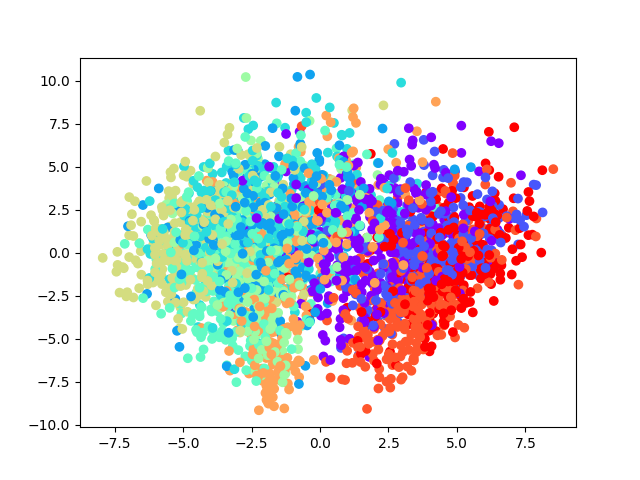
(2) 使用TSNE主成分分析
- 因为
t-SNE运行非常慢,所以这里先用PCA将到50维
|
|
- 数据区分还是比较明显的
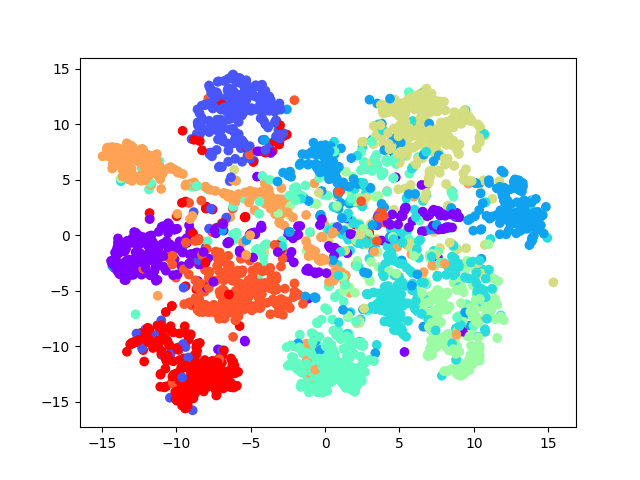
3、创建我们自己的网络
- 使用
prettytensor创建一个全连接层,使用softmax作为分类
|
|
- 优化器
|
|
- 准确度
|
|
SGD训练
|
|
- 使用
batch size预测测试集数据
|
|
- 本文链接: http://lawlite.me/2016/12/08/Tensorflow学习/
-
版权声明:
本博客所有文章除特别声明外,均采用 CC BY-NC-SA 3.0 许可协议
 。转载请注明出处!
。转载请注明出处!
